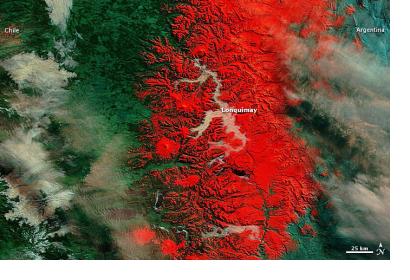In what the interior minister described as a “white earthquake,” heavy snow blanketed parts of Chile in July 2011. Snow was 2.3 meters (7.5 feet) deep in the city of Lonquimay, CNN reported. Santiago Times reported that some areas received four months’ worth of snowfall in just four days.
The Moderate Resolution Imaging Spectroradiometer (MODIS) on NASA’s Terra satellite captured images of the region around Lonquimay on July 22, 2011 (shown image), and July 8, 2011.
Using visible and infrared light, these images better distinguish between snow and clouds than a natural-color image would. Snow and ice are bright red or red-orange. Clouds range in color from off-white to peach. Vegetation is green.
Both images show winter conditions but, compared to the image from July 8, the scene from July 22 shows snow blanketing a significantly larger area around Lonquimay. On July 22, fog fills multiple valleys in between the snow-capped peaks.
The Araucanía region in central Chile included some of the hardest hit areas, CNN reported. The government sent food-laden trucks and military helicopters to the region’s remote areas, in hopes of reaching residents stranded by snow-packed roads. Meanwhile, Santiago Times said that frigid temperatures froze pipes, leaving most Lonquimay residents without water.
The heavy snow that buried the region around Lonquimay fell just weeks after rare snow covered parts of Chile’s Atacama Desert.

